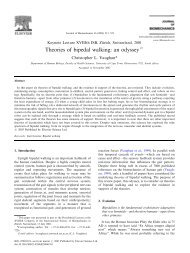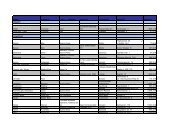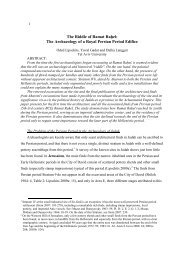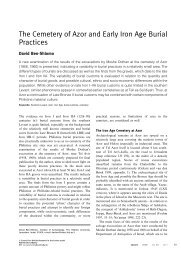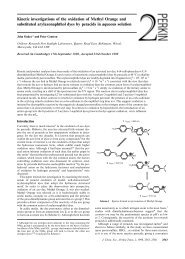Absorption and Transport of Cobalamin (Vitamin B12)
Absorption and Transport of Cobalamin (Vitamin B12)
Absorption and Transport of Cobalamin (Vitamin B12)
Create successful ePaper yourself
Turn your PDF publications into a flip-book with our unique Google optimized e-Paper software.
Annual Reviewswww.annualreviews.org/aronlineCOBALAMIN ABSORPTION & TRANSPORT 357Annu. Rev. Nutr. 1982.2:343-369. Downloaded from arjournals.annualreviews.orgby Hebrew University <strong>of</strong> Jerusalem on 11/18/08. For personal use only.has been shown by various workers that the TC II mediated uptake <strong>of</strong>vitamin takes place in a variety <strong>of</strong> tissues-- e. g. Hela cells <strong>and</strong> humankidney cells <strong>and</strong> human liver (54), reticulocytes (130), human placentalmembrane (58), human fibroblasts (132), Erhlich ascites cells (124),canine spleen <strong>and</strong> heart (76).Seligman & Allen (145) have obtained a receptor for TC II in pure formfrom human placenta, <strong>and</strong> suggested that TC II <strong>and</strong> its receptor might haveevolved from a common gene. They suggest that TC II might have evolvedas a nonglycosylated protein <strong>and</strong> the latter as a glycoprotein receptor suitablefor membrane insertion. The purified receptor had an association constant<strong>of</strong> 5.6 × 10~°M -1 for holo TC II, which was twice that for apo TC II(2.3 × 101°M-~). The higher affinity for the TC II-cbl complex confirms therole <strong>of</strong> the receptor in mediating transmembrane movement <strong>of</strong> cbl. Thishigh atfinity <strong>of</strong> the plasma membrane receptor for TC II-cbl is probably theexplanation for the reduction in TC II levels in plasma after an injection<strong>of</strong> cbl either intravenously (43) or intramuscularly (14). The TC II levelreturns to preinjection levels after several hours. However, the in vivoexperiments <strong>of</strong> Schneider et al (138) suggested that there was a 30% fasterrate <strong>of</strong> plasma clearance <strong>of</strong> [~25I]TC II compared to that <strong>of</strong> [12~I]TC II-[STCo]CNcbl. This observation is hard to reconcile with other studies (14,43, 145) indicating preferential affinity for the receptor for holo TC IIcompared to apo TC II.The uptake <strong>of</strong> TC II-cbl by endocytosis <strong>and</strong> the involvement <strong>of</strong> lysosomesin the degradation <strong>of</strong> TC II appear to be well recognized. Involvement<strong>of</strong> lysosomes in accumulating administered [58Co]cbl was shown inearlier studies using rat kidney (114). Using partially purified lysosomesfrom rat liver <strong>and</strong> kidney, Pletch & C<strong>of</strong>fey (125, 126) showed that one hourfollowing an intracardiac injection <strong>of</strong> [57Co]cbl the radioactivity was transientlyassociated with a protein fraction with a size similar to that <strong>of</strong>TC II.The internalization <strong>of</strong> TC II-cbl <strong>and</strong> subsequent degradation <strong>of</strong> TC II bylysosomes have been demonstrated more conclusively using cultured fibroblasts(169, 170). Decreased sensitivity to trypsin <strong>of</strong> [~2~I]TC II boundcell surfaces with an increase in temperature provides evidence for internalization.Decreased release <strong>of</strong> acid soluble radioactivity into the mediumafter the addition <strong>of</strong> 50 jaM chloroquine strongly suggests the involvement<strong>of</strong> lysosomes in the deg.radation <strong>of</strong> TC II (126).The exact mechanism <strong>of</strong> internalization <strong>of</strong> TC II-cbl is not known, <strong>and</strong>more morphological work is needed to ascertain whether cell surface redistributionoccurs after binding <strong>and</strong> results in the formation <strong>of</strong> specializedstructures such as coated pits. Such a mechanism has been demonstratedmorphologically for the internalization <strong>of</strong> low-density lipoproteins (10).



